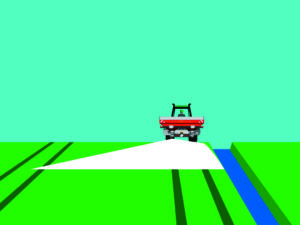Spreading
Boundary spreading
Legislation and regulations
Mineral fertilisers are harmful to aquatic organisms. Fertilisers must therefore be prevented from entering surface water because fertilisers in surface water are harmful to aquatic organisms. It is important to have a properly adjusted spreader with a boundary spreading device or accurate dosing equipment. Fertiliser spillage should be avoided as much as possible.
When fertilisers are being spread, a small proportion may end up in adjacent surface water. Fertilisers entering surface water cause water pollution. The Decree on Discharges from Open Cultivation and Livestock Breeding came into force in the Netherlands in 2000 with the aim of preventing this wherever possible. This Decree contains measures to prevent this pollution. Since 1 January 2013, the legislation and regulations surrounding boundary spreading have been included in the Environmental Management Activities Decree. For example, it is not permitted to apply fertilisers in a cultivation-free zone in close proximity to surface water. When applying granular fertilisers, a boundary spreading device must be used in the zone immediately adjacent to the cultivation-free zone.

Boundary spraying with liquid fertilisers
When spraying liquid fertilisers, the boundaries of the plot can be fertilised very precisely. Boundary spraying with liquid fertilisers is therefore considerably easier than boundary spreading with granular fertilisers.
Liquid fertilisers must not enter surface water during plot boundary spraying operations. When applying foliar fertilisers next to surface water, it is mandatory to use low-drift nozzles next to the cultivation-free zone. In addition, nozzles should not be higher than 50 cm above the crop or soil. Spraying is not allowed when wind speed exceeds 5 m/s.
The sprayer may be filled from surface water, provided that a buffer tank or non-return valve is used.
Methods of boundary spreading
There are two ways of spreading the edge of a plot. A distinction is made between:
- Spreading from the side;
- Spreading to the side.
Spreading from the side

With spreading from the side, the plot is spread from the edge of the field. This method is recommended in basic fertilisation, as a better spreading pattern can be achieved than with spreading to the side. With spreading from the side, a short distance is driven along the plot edge, ensuring that the last few metres before the plot edge are well fertilised.
Spreading from the side is usually done using a splash plate.
In a twin-disc spreader, one outlet (inlet of the outer disc) is closed. When a hydraulic spreader is used, it is possible to tilt the spreader and close the outer side.
Spreading to the side

Spreading to the side involves spreading from the plot to the boundary. This method is often used in supplementary fertilisation as it allows you to drive in the spray tracks. You then drive on half the working width of the plot boundary. Different spreader manufacturers use various systems for spreading to the side. In general, these systems do not work as well as with spreading from the side. A major disadvantage of spreading to the side is that it is impossible to achieve adequate fertilisation at the plot edge. The last few metres of the plot usually receive too little fertiliser.
When spreading to the side, modern fertiliser spreaders allow you to choose between yield-oriented and environmentally-oriented spreading. The difference between the two systems is that yield-oriented boundary spreading involves spreading more fertiliser over the edge of the plot. As a result, the last few metres of the field edge receive more fertiliser than with environmentally-oriented boundary spreading. However, if you are spreading alongside ditches, you should make sure to minimise the emission of fertilisers into ditches and use environmentally-oriented spreading.
Boundary spreading systems
Today, all new spreaders are equipped with boundary spreading systems or accessories to spread field edges. The different systems produced by spreader manufacturers are often similar. The following systems are the most common:
- Boundary spreading spout;
- Splash plate;
- Tilt cylinder;
- Boundary spreader vanes;
- Guides.
Boundary spreading spout
When fitted to a pendulum spreader, a boundary spreading spout can be used to prevent fertilisers from entering surface water. A major disadvantage of this system is that after spreading the plot edge, you need to remove the boundary spreading spout and refit the regular spreading spout.
Splash plate
 The boundary spreading plate is one of the simplest systems, as only a splash plate needs to be mounted on the spreader. This system is used in spreading from the side. All pendulum spreaders are usually equipped with this system. A disadvantage with older pendulum spreaders is that the plate has to be removed and refitted.There are also several twin-disc spreaders which are fitted with a splash plate. An advantage with new spreaders is that they are fitted with a hydraulic boundary spreading plate. In this case, manual removal and refitting is no longer necessary. The disadvantage of this system is that the granules often snap on the splash plate. As a result, many granules near the splash plate immediately fall to the ground. This will result in over-fertilisation.
The boundary spreading plate is one of the simplest systems, as only a splash plate needs to be mounted on the spreader. This system is used in spreading from the side. All pendulum spreaders are usually equipped with this system. A disadvantage with older pendulum spreaders is that the plate has to be removed and refitted.There are also several twin-disc spreaders which are fitted with a splash plate. An advantage with new spreaders is that they are fitted with a hydraulic boundary spreading plate. In this case, manual removal and refitting is no longer necessary. The disadvantage of this system is that the granules often snap on the splash plate. As a result, many granules near the splash plate immediately fall to the ground. This will result in over-fertilisation.
Tilt cylinder

When spreading from the spray track, the spreading path can be limited by tilting the spreader. A cylinder raises or lowers the spreader on one side. This system can be used with various pendulum and twin-disc spreaders. One advantage of this system is that it is easy to operate from the tractor cab and does not require parts to be removed and refitted.
The disadvantage with this system is that there is no good connection with the next pass when spreading wide.
Boundary spreading vanes

In a number of spreader brands, the spreader disc is equipped with a boundary vane for boundary spreading. There are systems where the outlet funnel moves, causing the fertiliser to fall in front of the boundary vane.
Integrated boundary spreading systems are also available. In these systems, the feed vanes are rotated, directing fertiliser to the smaller boundary spreader vanes. In this case, it is also possible to reduce the spreading quantity when boundary spreading. Both systems can be operated electronically from the tractor.
Guides

Some twin-disc spreader manufacturers use a system in which curved ‘slats’ ensure that the fertiliser is distributed at the edge of the plot. This system is used for spreading to the side. The slats deflect the trajectory of the granules, reducing their spread. Depending on the type of spreader, the system can be folded down hydraulically or mechanically.
Issues concerning boundary spreading
In order to achieve good results with boundary spreading, there are a number of major issues to be considered:
- Before commencing spreading operations, read the section of the spreader manual concerning boundary spreading. This often contains a lot of information on how the system works and should be used;
- After spreading the plot edges, switch the spreader from boundary spreading to regular spreading.
Source:
Agripress, 2010.
Amazone
Berg, 2013
Blanken, 2012
Broek, Kunstmeststrooiers: afstelling is alles, 2008.
Hoving, 2012.
Korver, 2014.
Kverneland Group, 2014.
Rijkwaterstaat.
Roelofs, 2014.
Turenhout, 2014.
Vicon


